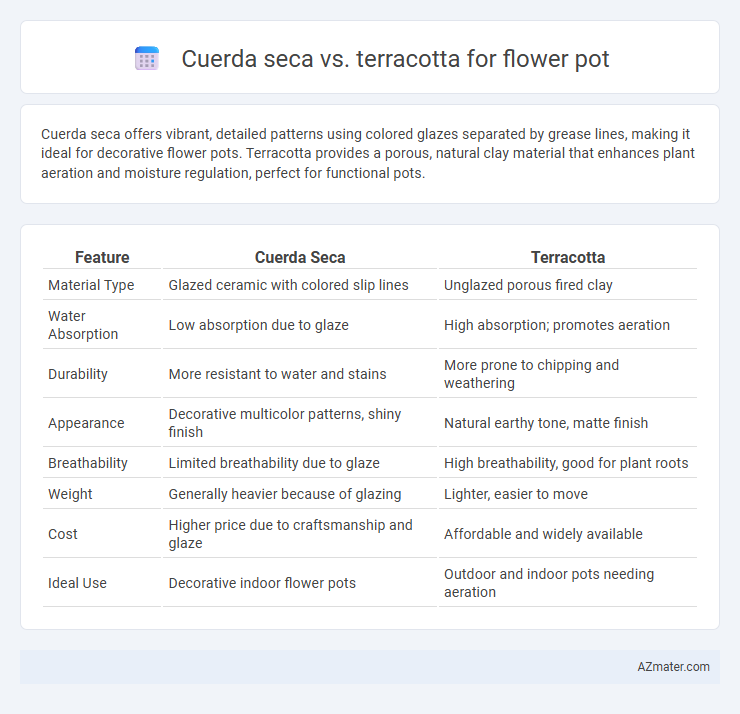Cuerda seca offers vibrant, detailed patterns using colored glazes separated by grease lines, making it ideal for decorative flower pots. Terracotta provides a porous, natural clay material that enhances plant aeration and moisture regulation, perfect for functional pots.
Table of Comparison
| Feature | Cuerda Seca | Terracotta |
|---|---|---|
| Material Type | Glazed ceramic with colored slip lines | Unglazed porous fired clay |
| Water Absorption | Low absorption due to glaze | High absorption; promotes aeration |
| Durability | More resistant to water and stains | More prone to chipping and weathering |
| Appearance | Decorative multicolor patterns, shiny finish | Natural earthy tone, matte finish |
| Breathability | Limited breathability due to glaze | High breathability, good for plant roots |
| Weight | Generally heavier because of glazing | Lighter, easier to move |
| Cost | Higher price due to craftsmanship and glaze | Affordable and widely available |
| Ideal Use | Decorative indoor flower pots | Outdoor and indoor pots needing aeration |
Introduction to Cuerda Seca and Terracotta Flower Pots
Cuerda seca flower pots feature intricate, multicolored designs created using a resist technique that separates glazes during firing, resulting in vibrant and detailed patterns. Terracotta flower pots, made from natural clay, are prized for their porous texture that promotes aeration and moisture regulation for plant roots. Both materials offer unique aesthetic and functional benefits, with cuerda seca emphasizing decorative artistry and terracotta focusing on practicality and natural appeal.
Historical Background of Cuerda Seca and Terracotta
Cuerda seca, originating in 10th-century Moorish Spain, is a ceramic technique involving colored glazes separated by a greasy substance to prevent blending, often seen in intricate tilework and pottery. Terracotta, dating back to ancient civilizations like Mesopotamia and the Indus Valley, is an unglazed, porous clay ceramic renowned for its durability and natural earthy appearance in flower pots. Both materials have distinct historical roots, with cuerda seca prized for its decorative glazing methods and terracotta valued for its practicality and breathability in plant cultivation.
Materials and Crafting Techniques
Cuerda seca pottery employs a resist technique using greasy substances and colored glazes to create intricate, vibrant patterns on ceramic surfaces, typically fired at high temperatures to achieve durability. Terracotta flower pots are made from natural, porous clay, shaped by hand or wheel, and fired at moderate temperatures, resulting in a porous material that enhances breathability for plant roots. While cuerda seca emphasizes decorative complexity through multi-colored glaze applications, terracotta prioritizes functional simplicity and natural aesthetics derived from its earthy clay composition.
Aesthetic Differences: Visual Appeal and Design
Cuerda seca flower pots feature intricate, multicolored glaze patterns created by a wax resist technique, offering a vibrant and glossy aesthetic that highlights detailed motifs and bold contrasts. Terracotta pots present a warm, earthy, and rustic look with natural reddish-brown hues, emphasizing simplicity and organic texture that matures beautifully over time. The distinct visual appeal of cuerda seca suits decorative, artistic spaces, while terracotta complements minimalist or natural garden settings.
Durability and Weather Resistance
Cuerda seca techniques use colored glazes separated by grease lines that can chip or fade when exposed to harsh weather, making them less durable for outdoor flower pots. Terracotta flower pots, crafted from porous clay, excel in durability and weather resistance due to their natural breathability and ability to withstand temperature fluctuations without cracking. Choosing terracotta ensures long-lasting flower pots with superior resistance to sun, rain, and frost compared to the more delicate glazed cuerda seca options.
Water Retention and Plant Health
Cuerda seca pots feature intricate glazed patterns that enhance water retention by reducing soil evaporation, promoting consistent moisture levels ideal for plant health. Terracotta pots, being porous, allow natural air and water exchange but tend to dry out faster, requiring more frequent watering to maintain optimal plant hydration. Selecting cuerda seca pots supports sustained water availability, while terracotta suits plants preferring well-drained soil conditions.
Maintenance and Cleaning Requirements
Cuerda seca flower pots require careful cleaning with a soft cloth and mild detergent to preserve their intricate glaze and avoid damage to the colored outlines. Terracotta pots demand regular maintenance to prevent salt buildup and mold, often involving soaking and scrubbing with a brush to remove dirt from their porous surfaces. Both materials benefit from thorough drying before reuse, but terracotta is generally more porous and may require sealing to reduce water absorption and prolong durability.
Environmental Impact and Sustainability
Cuerda seca flower pots require less water in production and use natural mineral pigments, resulting in a lower carbon footprint compared to terracotta, which demands high-temperature kilns and substantial energy consumption. Terracotta is biodegradable and made from natural clay, providing excellent sustainability through its natural decomposition without harmful residues. Choosing between the two hinges on balancing cuerda seca's energy-efficient pigment use against terracotta's inherent eco-friendly and compostable material properties.
Cost Comparison and Accessibility
Cuerda seca flower pots generally cost more due to the intricate glazing process that enhances durability and decorative appeal, while terracotta pots remain budget-friendly with their simpler, natural clay composition. Accessibility for terracotta pots is widespread, available in most garden centers and home improvement stores, whereas cuerda seca pots are often found in specialty shops or online artisan marketplaces. Cost efficiency and easy availability make terracotta the preferred choice for average gardeners, whereas cuerda seca appeals to collectors seeking unique, vibrant designs despite higher prices.
Final Verdict: Choosing the Right Pot for Your Garden
Cuerda seca pots offer intricate, colorful glazing that enhances aesthetic appeal and provides durable water resistance, ideal for decorative garden spaces. Terracotta pots excel in breathability and natural temperature regulation, promoting healthy root growth and moisture control for most plants. Choosing the right pot depends on whether visual artistry or plant health is the primary goal, with terracotta best suited for traditional gardening needs and cuerda seca for ornamental displays.

Infographic: Cuerda seca vs Terracotta for Flower Pot
 azmater.com
azmater.com